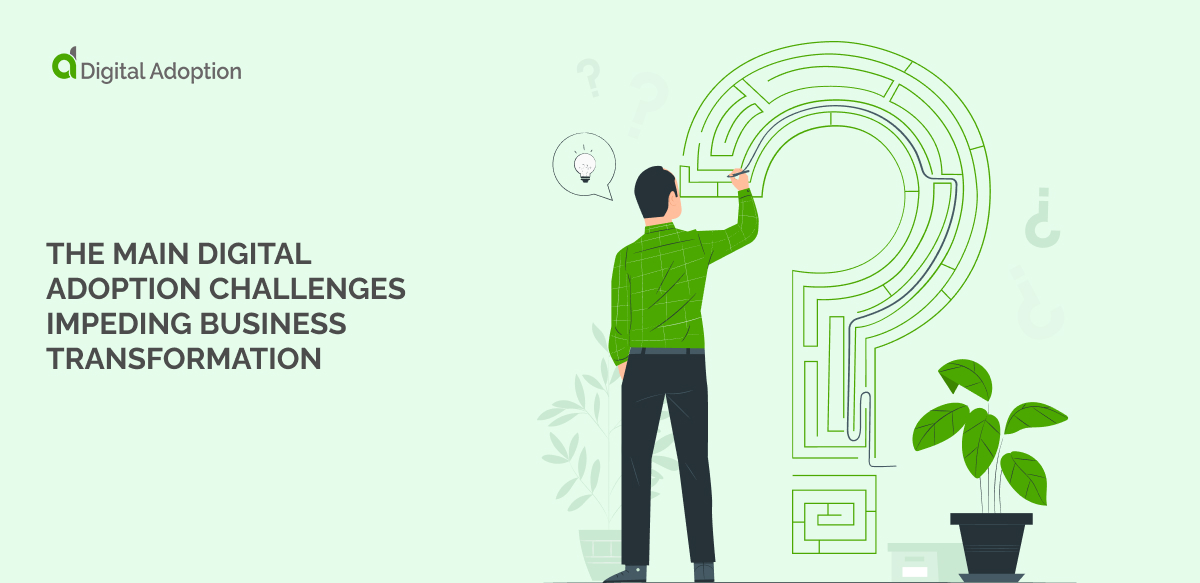Digital transformation efforts must constantly evolve to capture the potential of both new and existing technologies.
While the main objective of digital transformation (DX) is the successful implementation of new technologies to improve business processes, the responsibilities of industry leaders at the helm of DX initiatives also include the competent application and digital adoption of new technologies by end-users.
A lack of top-down leadership, organizational vision, software implementation, and classroom training are just a few common digital adoption challenges IT leaders face when pursuing digital transformation. This requires agile change management on behalf of business and IT leaders as a prerequisite for success.
An agile digital adoption strategy may include enhanced technology investment, upgrading legacy systems, reinvigorating traditional training methods, and the use of digital adoption platforms (DAP). DX leaders are encouraged to reiterate the value of change in company culture while sourcing solutions that help organizations derive maximum value from bleeding-edge digital tech.
This article will address the most pertinent digital adoption challenges impeding business innovation today and provide actionable solutions for navigating successful digital transformation.
What Is Digital Adoption?
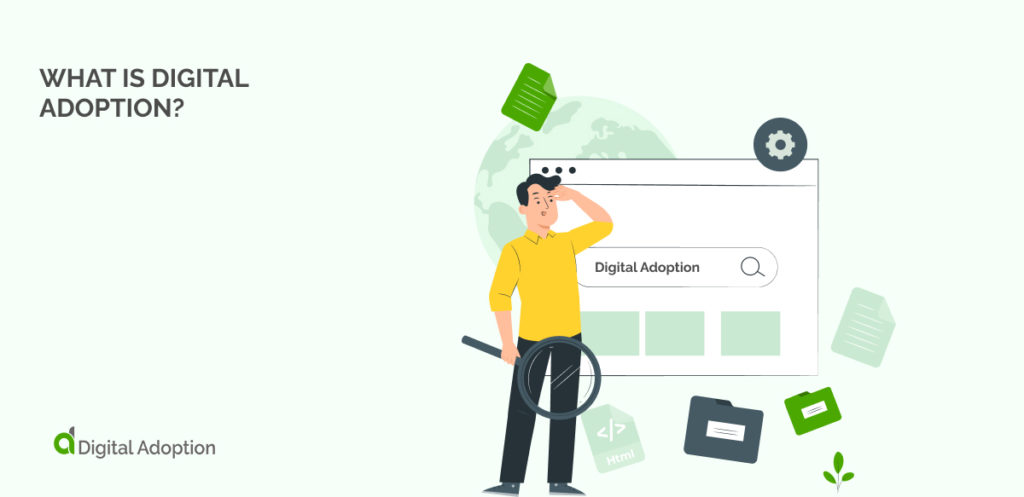
Digital adoption involves leveraging digital technologies like the internet, big data analytics, cloud computing, mobile devices, and social media to update existing business processes and support digital transformation efforts.
More specifically, a digital adoption platform (DAP) is a software solution providing end-to-end educational processes that develop brand-new users with minimal understanding of technology into informed users who can competently exploit digital technology to the fullest. Digital adoption is important because it accelerates technology integration and enables users to fully exploit its benefits. When done right, digital adoption increases productivity, efficiency, and innovation across all business areas.
The Value of Digital Adoption
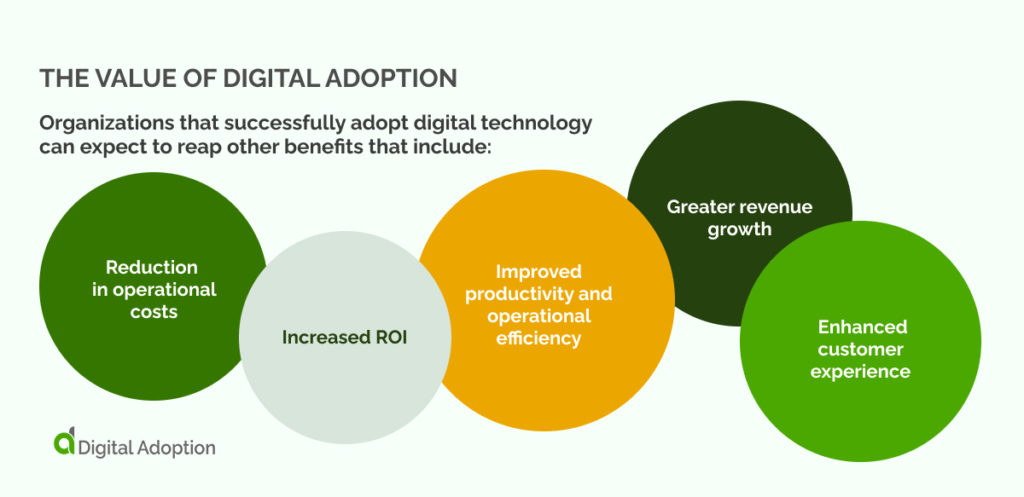
The value of digital adoption is realized mostly in its ability to help organizations keep up with technological trends and drive business efficiency. Digital technologies are rapidly changing how we live, work, and interact—making it essential for organizations to embrace these changes to thrive in an increasingly digital world. Doing so encourages business transformation while putting organizations in a better position to innovate and adapt quickly to change.
Organizations that successfully adopt digital technology can expect to reap other benefits that include:
- Increased ROI
- reduction in operational costs
- improved productivity and operational efficiency
- enhanced customer experience
- greater revenue growth
Statista reports, “Increasing operations efficiency, transforming existing business processes, and optimizing employee digital experience are the most important business initiatives amid the coronavirus (COVID-19) pandemic.”
This reaffirms the need for business and IT leaders to embrace new technologies like artificial intelligence (AI), big data analytics, cloud solutions, and machine learning (ML) to stay ahead of the curve and drive innovation.
Businesses must proactively adapt and evolve alongside the emergence of new technology while infusing it into processes, systems, and strategies that continue to support business objectives.
Common Barriers To Digital Adoption

While digital adoption holds great promise for businesses, it also presents several challenges.
87% of businesses expect to feel the effects of digital disruption in their industry, but only 44% of businesses are prepared for such disruption, according to Deloitte.

One of the biggest challenges is resistance to organizational change. Business leaders must clearly communicate the need for digital adoption and address existing concerns about its impact on jobs, processes, systems, and culture. Another is the need for more resources and adequate vision. To solve this, business leaders are encouraged to reassess organizational capacity and launch a framework for predicting the future state of an organization’s digital operations.
A lack of relevant skills also poses further challenges. The rapid pace of change in technology makes it difficult for organizations to develop the talent they need to implement and manage DX initiatives. And so, there is a need for organizational learning and development to ensure that employees are equipped with the skills required to thrive in a digital world. Let’s take a more in-depth look at some of these challenges.
The Top Digital Adoption Challenges Impeding Business Transformation
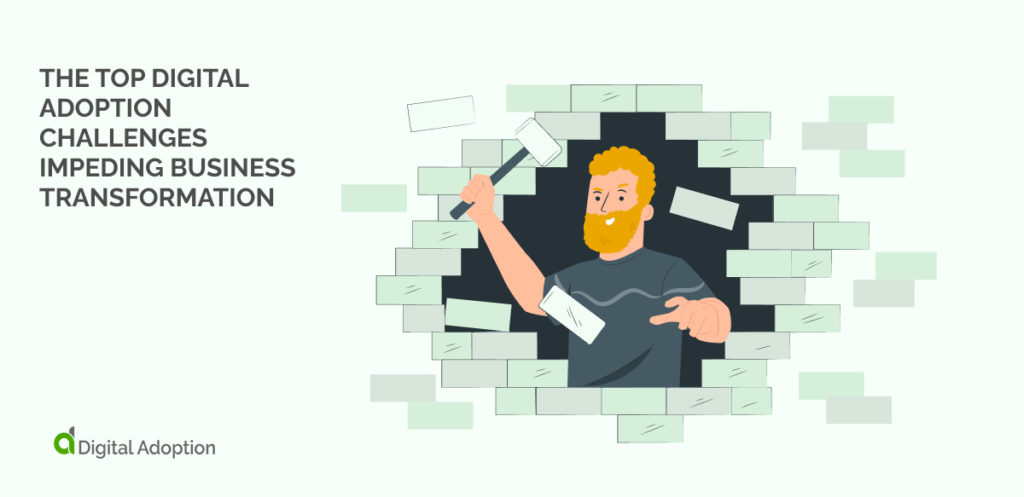
- Resistance To Change
Change is the only constant in business. With digital adoption being a change process, business leaders must create the conditions and foster a company culture in which an organization is conducive to change.
Many leaders need help to see the value of change and are often reluctant to embrace new technologies. This can lead to a lack of organizational foresight and understanding of how digital adoption positively impacts the business, processes, and employees. Moreover, because employees make up most end users, digital transformation efforts are at threat of stagnation when employees resist change.
MIT’s Sloan School of Management reports that the profitability of agile organizations is 30% higher than non-agile organizations. Agile organizations also experience 37% faster revenue growth.
Change resistance can also manifest in IT departments, where IT staff can become entrenched and slow to adopt new technologies. IT groups resistant to change can prevent digital adoption and hinder business innovation, leading to slower time-to-market for new IT projects. Solutions for change resistance include communicating the benefits of digital adoption, ongoing training and support for end users, and a culture that fosters continuous learning.
- IT Capacity Issues
As organizations adopt new technologies, IT departments often struggle to keep up with the growth in workload and complexity. IT departments often don’t have the resources to support new IT projects, and IT leaders are tasked with making difficult decisions about IT priorities.
In addition, IT leaders may lack the skills and knowledge to effectively manage digital transformation projects, which can impact IT performance and have a negative impact on IT-business alignment. Solutions for IT capacity issues include investing in IT education and training programs and organizational transformation efforts that enable IT to support evolving business needs.
Moreover, business leaders can better support their IT teams and accelerate organizational objectives by investing in IT infrastructure that is flexible, scalable, and resilient. They may also leverage IT outsourcing, consulting services, infrastructure management, and cloud solutions to maximize digital adoption processes.
- Lack of Talent
As IT departments adopt new technologies and adapt to changing needs, IT leaders are tasked with hiring talent to help them achieve business goals. However, finding the right IT professionals with the skills necessary to support digital transformation efforts can take time and effort. And so, IT leaders must be proactive in their recruitment and retention strategies, leveraging resources such as job boards, alumni networks, conferences and events, and certified IT training programs to acquire new talent.
InStride revealed that “66% of business leaders agree that strategic education programs attract new talent.“
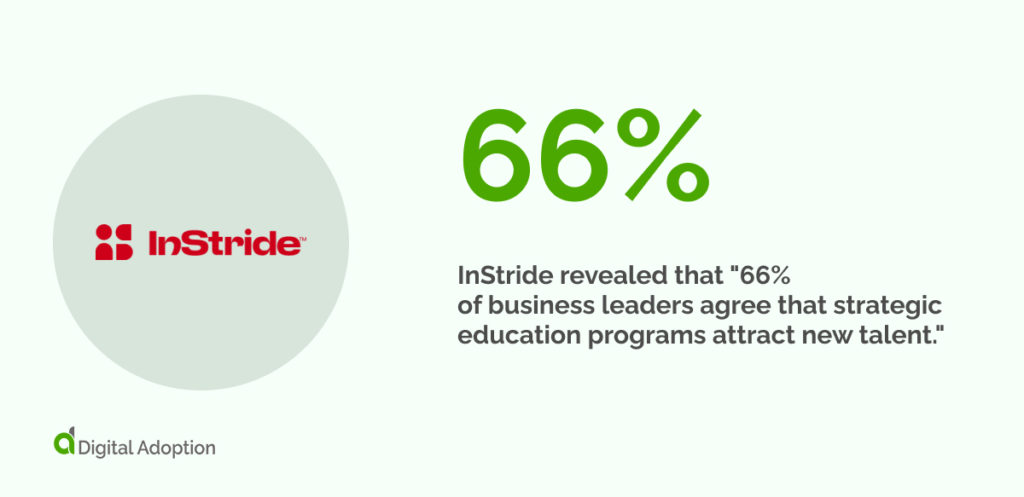
IT leaders must create a collaborative and innovative environment to attract talent. And so, IT leaders must invest in training and professional development programs to help IT staff grow their skills, stay current on industry trends, and practice agility. By doing so, IT departments can continue to evolve with digital technologies and support business objectives through innovative practices.
- Lack of Relevant Skills
As the pace of technological change continues to accelerate, businesses need employees with relevant technical skills. Digital adoption requires expertise in new technologies like cloud computing, big data analytics, artificial intelligence, blockchain, and machine learning.
However, not all employees have the skills necessary to support digital transformation efforts, and hiring new employees with specialized skills isn’t a feasible solution each time a new technology emerges. Consequently, digital adoption models must focus on continuous learning and training programs that provide employees with the skills they need to adapt to changing technologies.
According to UiPath, “86% of office workers say they wish their employer offered opportunities to acquire new skills, and 83% say they wish their employer gave them more opportunity to enhance their current skills.”

IT leaders must invest in retraining their current employees to help them acquire new skills and stay relevant, or their digital skills may be at risk of becoming obsolete. To nurture existing talent, IT leaders can create learning and development opportunities and provide hands-on training that enables employees to succeed in increasingly digitized environments.
- Subpar Software Training
Software training is a major obstacle hindering successful digital adoption because it needs to be delivered in a practical and engaging way. Training methods like manuals and PowerPoint presentations can be difficult for employees to follow, and training sessions that are shorter or more varied can be effective.
To effectively train employees on new software, IT leaders must create engaging training programs tailored to employees’ needs and learning styles. Training methods like interactive tutorials, gamification, hands-on training, and reference guides can help employees quickly and easily understand the software. IT leaders can also partner with vendors to provide customized training programs tailored to their IT departments’ needs.
IT leaders must ultimately prioritize delivering effective software training to adopt new digital technology and stay competitive. By investing in training and development programs that motivate employees to learn, IT leaders can support their teams in successfully navigating the digital transformation journey.
- Inadequate Impact Evaluations
The inability to evaluate how new technologies are performing and impacting people and processes can often be the reason behind failed digital adoption initiatives.
Traditionally, impact evaluation has focused on IT-related metrics like cost reduction and process efficiency. However, to successfully evaluate the impact of new technologies, IT leaders must understand how they affect broader business outcomes like customer satisfaction and employee performance.
Prioritizing impact evaluations within the digital adoption lifecycle will help IT leaders make data-driven decisions about optimizing their existing technologies and implementing new ones. They can use impact evaluation data to evaluate the ROI of new technologies and make informed decisions about allocating their IT budgets.
To effectively evaluate the impact of new technologies, IT leaders must ensure that their evaluation methods align with their organization’s goals and priorities. They should also invest in data analytics tools that can help them collect and analyze large datasets and work closely with their IT teams to interpret the impact evaluation data. By prioritizing impact evaluations and using data-driven decision-making, IT leaders can ensure the success of their digital transformation initiatives.
- Prolonged Remote Work Models
Long-held working models were thrown into chaos amidst the fallout of the COVID-19 pandemic, and remote and hybrid work soon emerged as the solution for sustaining business operations.
However, as we move into 2023, remote and hybrid work models have become a permanent fixture of working life and will likely remain as such. This has led to a need for more available support and help for employees in siloed work environments. Employees often lose time trying to troubleshoot avoidable technical errors, leaving them unable to efficiently or productively fulfill obligations and meet KPIs.
The inability to seek support from IT teams and co-workers to solve IT problems is a major challenge facing organizations today. To address this issue, IT leaders must prioritize the development of persuasive digital adoption tools and resources that can help employees quickly resolve IT-related matters on their own.
Some potential solutions to this challenge include implementing a digital adoption platform (DAP) that provides employee self-service capabilities, leveraging AI-powered chatbots to respond to IT issues in real-time, and developing targeted training programs that help employees quickly learn the ins and outs of new software and tools.
Remote work solutions also include cloud-based office suites and a Remote Desktop Application. Cloud-based office suites allow users to work remotely from any computer or device and help them collaborate with their team, access files and communicate with each other via chat tools.
In comparison, remote desktop apps allow users to access their computer remotely and control it as if they were sitting in front of it. These solutions offer many benefits for organizations that rely on remote employees and need to better support their IT needs.
In Buffer’s 2019 State of Remote Work survey, 99% of respondents say they would like to work remotely, at least some of the time, for the rest of their careers. In addition, 95% of workers already working remotely said they would recommend remote work to other people.
- Poor Digital Adoption Strategies
When deploying new digital applications, organizations often expect users to adopt these systems and tools without the know-how or motivation to utilize them fully.
Organizations launching DX initiatives face operational stagnancy and change resistance because they need to implement a digital adoption strategy that considers the impacts of new digital technology. And so business processes and workflows become inefficient, and employee productivity is decreased due to technology failure and user adoption lags.
To combat this challenge, IT leaders must put a digital adoption strategy at the forefront of their DX initiatives. A solid digital adoption strategy should start with crafting an impact evaluation plan to better understand how a new technology or software will impact their business, working closely with IT teams to implement proper training programs where needed, and using data analytics tools to understand how successful their new DX initiative has been.
These steps will help IT leaders better understand their organization’s needs, recognize and address pain points, and support the success of their digital transformation initiatives.
Other potential solutions to this challenge include:
- Customized training courses for employees
- On-demand support tools that offer users real-time assistance and help them to troubleshoot issues
- Implementing an employee adoption dashboard that provides information on user adoption and the use of digital tools
- Creating a community of peers to share knowledge and best practices
- Using digital adoption platforms that help users access, install, and troubleshoot new software
Six Critical Steps For Building A Successful Digital Adoption Strategy
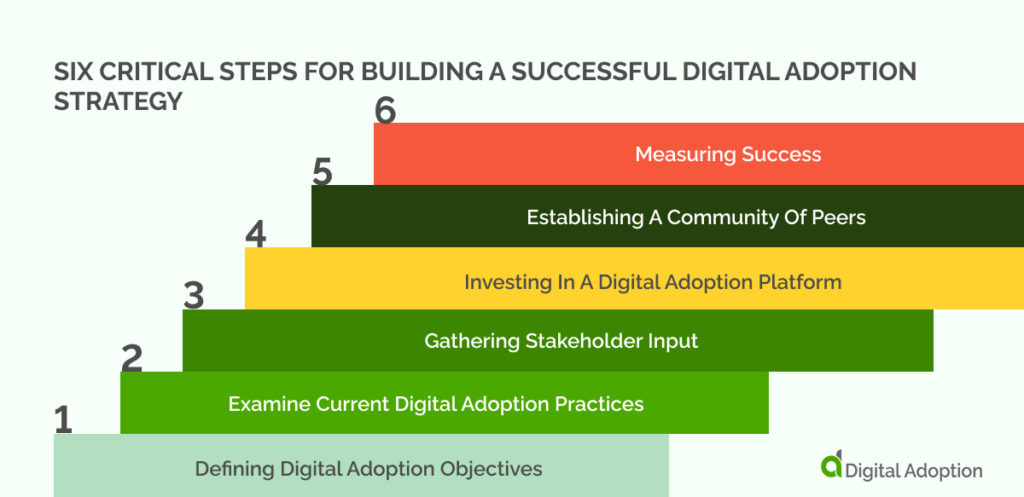
The six key steps for building a successful digital adoption strategy include:
1. Defining Digital Adoption Objectives – Organizations must clearly define their digital adoption strategy’s goals and objectives, including what they hope to achieve regarding user adoption and business outcomes. This may include improving productivity, reducing IT costs, or enhancing user satisfaction with new technologies.
2. Examine Current Digital Adoption Practices – Organizations should look closely at the current state of their digital adoption practices and initiatives. This will help them identify areas where improvements can be made and any existing challenges or obstacles hindering success
3. Gathering Stakeholder Input – DX officers will need input and buy-in from key organizational stakeholders, including IT teams, senior managers, and end users, to ensure an effective digital adoption strategy
4. Investing In A Digital Adoption Platform – Another critical component of any successful digital adoption strategy is leveraging specialized platforms or tools that offer real-time assistance and help users navigate new technologies. This can include chatbots, virtual assistants, or other AI-powered tools that allow users to get instant feedback and support in real-time
5. Establishing A Community Of Peers – In addition to leveraging digital adoption platforms, organizations should consider establishing a community of peers as part of their digital adoption strategy. This can include establishing an online forum where users can share ideas, ask questions, and collaborate with employees using the same software or tools
6. Measuring Success – It is important to continually monitor and measure the success of digital adoption initiatives over time to identify areas for improvement and determine if investing in these strategies is paying off. This can include analyzing user adoption data, monitoring usage metrics, or establishing key performance indicators (KPIs) aligned with overall business goals.
The Key To Solving Digital Adoption Challenges
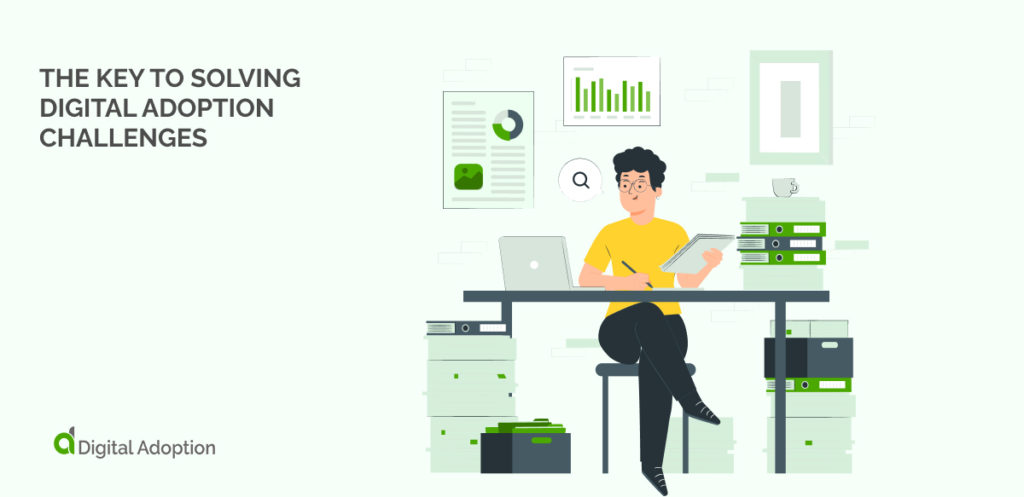
Overall, the main thing to remember about overcoming digital adoption challenges is that technology-driven disruptions have complex implications for business and require a strategic, holistic approach to adoption.
Organizational silos create challenges when implementing digital adoption practices, as does a lack of time and resources. Organizations must adequately implement a digital adoption strategy that considers people, processes, and technology to ensure their digital initiatives’ success.
This will ensure success for digital adoption initiatives and wider business goals while empowering employees to succeed at their jobs. By creating a culture of digital adoption, organizations can provide the necessary support for users to maximize the benefits of new technology.

 FACT CHECKED
FACT CHECKED